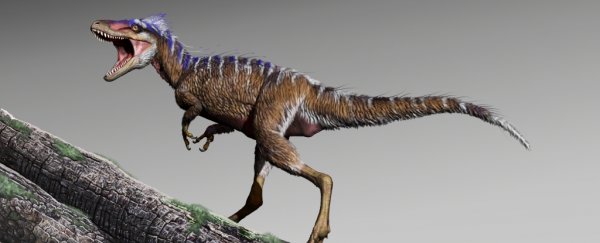Is there any dinosaur more iconic than Tyrannosaurus Rex? Its mighty jaws and fierce mien ignite the imaginations of four-year-olds everywhere. It's the dinosaur poster child - yet this fearsome beast's beginnings were, new evidence suggests, quite humble.
How humble? Well, a little smaller than a kangaroo, as we now know from a newly discovered T. rex ancestor. And the wee beastie, which hails back to the Cretaceous 96 million years ago from what is now Utah, is helping close a 70-million-year gap in the T. rex fossil record.
Its name is delightful: Moros intrepidus. It was named after Greek god Moros, who represents impending doom; and the word intrepid, because its ancestors originated in another continent.
So a rough translation would be "Adventurous Doombringer" - isn't that just the best dinosaur name you've ever heard?
It's the first tyrannosaur to have been found from its time period. We have earlier evidence of medium-sized, primitive tyrannosaurs on the North American continent dating back to the Jurassic, about 150 million years ago. But they were overshadowed by allosaurus - bigger and tougher, the top predator of the day.
So there's this gap until around 81 million years ago, during the Cretaceous, when big T. rex emerged (although a 'missing link' tyrannosaur called Timurlengia euotica from 90 million years ago was recently found in Uzbekistan).
This issue has been eating away at palaeontologists (pun intended).
So palaeontologist Lindsay Zanno of North Carolina State University mounted an expedition to search for them - and, after 10 years, they found teeth and a hind leg that ended up belonging to the previously unknown M. intrepidus.
Interestingly, its teeth showed similarities to teeth from Asian tyrannosaurs - evidence that the little Doombringer's ancestors had made its way to North America from the Asian continent via a Beringian land bridge, at least 30 million years prior.
The dino was titchy. It was nearly fully grown - six or seven years old when it died - but it stood just 90-120 centimetres (3-4 feet) at the hip, and weighed just 78 kilograms (172 pounds) or thereabouts.
The size is a far cry from its late Cretaceous descendants, which clocked in at between 5,000 and 7,000 kilograms (11,000 to 15,500 pounds), but that doesn't mean M. intrepidus was a limp fish.
"Moros was lightweight and exceptionally fast. These adaptations, together with advanced sensory capabilities, are the mark of a formidable predator. It could easily have run down prey, while avoiding confrontation with the top predators of the day," Zanno said.
So, as the allosaur declined, the tiny little tyrannosaur used its speed and size to its advantage, working its way up from zero to hero - or "wallflower to prom king," as Zanno put it.
"Although the earliest Cretaceous tyrannosaurs were small, their predatory specialisations meant that they were primed to take advantage of new opportunities when warming temperatures, rising sea-level and shrinking ranges restructured ecosystems at the beginning of the Late Cretaceous," she said.
"We now know it took them less than 15 million years to rise to power."
Don't mess with tyrannosaurs, you guys.
The team's research has been published in the journal Communications Biology.
